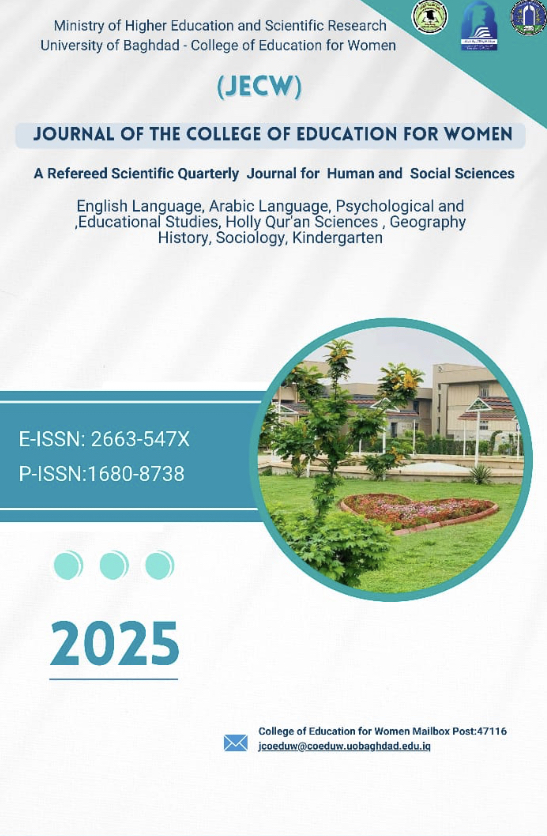Abstract
Five mixed primary schools from the district of Tikrit/ Salah al- din province
with a total of 100 male and female pupils and two ages(8-9 and 10-11 years),
were selected randomly to study the relationship between the breakfast meal and
the academic level, the socioeconomic situation, and the number of family
members. The study showed a positive linear correlation between the morning
meal, and academic level of students for both two covered ages, also showed a
clear impact between the development of family's socioeconomic situation and
their nutrition level. There were an increase in the percentage of pupils aged 8-9
years with a poor nutrition when they were belonged to a poor or medium
socioeconomic families, with the absence of students with poor nutrition at the
improvement family level to verygood . The medium level of nutrition indicates a
higher percentage when the students belongs to a good economic situation, while
the level good and verygood nutrition gives an increase in the percentage of
students; with the improvement at the socioconomic level of the family with a
different rates of increasing, noting the absence of students with good and
verygood nutrition in the case of inferior status of the family. Same relationship for
pupils aged 10-11 were shown. Also there were an effect of the number of family
members to which these students were belonged on the level of nutrition, there
were adecrease in the level of nutrition for these students commensurate with the
increase in family members for both two covered age. From this we can conclude
that there were an opposite effect for both of the socioeconomic situation, and the
number of family members on the academic level of the students for both two
covered ages
with a total of 100 male and female pupils and two ages(8-9 and 10-11 years),
were selected randomly to study the relationship between the breakfast meal and
the academic level, the socioeconomic situation, and the number of family
members. The study showed a positive linear correlation between the morning
meal, and academic level of students for both two covered ages, also showed a
clear impact between the development of family's socioeconomic situation and
their nutrition level. There were an increase in the percentage of pupils aged 8-9
years with a poor nutrition when they were belonged to a poor or medium
socioeconomic families, with the absence of students with poor nutrition at the
improvement family level to verygood . The medium level of nutrition indicates a
higher percentage when the students belongs to a good economic situation, while
the level good and verygood nutrition gives an increase in the percentage of
students; with the improvement at the socioconomic level of the family with a
different rates of increasing, noting the absence of students with good and
verygood nutrition in the case of inferior status of the family. Same relationship for
pupils aged 10-11 were shown. Also there were an effect of the number of family
members to which these students were belonged on the level of nutrition, there
were adecrease in the level of nutrition for these students commensurate with the
increase in family members for both two covered age. From this we can conclude
that there were an opposite effect for both of the socioeconomic situation, and the
number of family members on the academic level of the students for both two
covered ages
Abstract
اختيرت خمسة مدارس ابتدائية مختلطة في قضاء تكريت محافظة صلاح الدين بصورة عشوائية وبما مجموعه ۱۰۰ تلميذ وتلميذة وبعمرين اشتملا على ٨-٩ سنوات و ۱۰-۱۱ سنة الدراسة العلاقة بين وجبة الأفطار وبين كل من المستوى الدراسي والحالة الاجتماعية والاقتصادية فضلاً عن عدد افراد الاسرة. اظهرت الدراسة وجود علاقة طردية بين تناول وجبة الأفطار والمستوى الدراسي للتلاميذ قيد الدراسة وللعمرين المشمولين كما اظهرت وجود تأثير واضح لوضع العائلة الاقتصادي والاجتماعي في مستوى تغذيتهم، وان هنالك ارتفاعا في نسبة التلاميذ بعمر ۸-۹ سنوات ذوي مستوى تغذية رديء في حالة انتمائهم الى عوائل ذات حالة اقتصادية واجتماعية ردينة أو متوسطة مع ملاحظة فقدان التلاميذ ذوي التغذية الردينة عند تحسن مستوى العائلة الى جيد جدا. اما مستوى التغذية المتوسط فأظهر اعلى نسبة له عند امتلاك العائلة التي ينتمي اليها التلاميذ قيد الدراسة حالة اقتصادية جيدة، في حين أعطى مستوى التغذية جيد وجيد جداً ارتفاعا في نسب التلاميذ تناسبت مع التحسن في المستوى الاقتصادي والاجتماعي للعائلة مع الاختلاف في نسب الزيادة، ولوحظ عدم وجود طلبة ذوي تغذية جيدة في حالة وضع العائلة الردئ وهي الملاحظة نفسها التي أظهرها مستوى التغذية جيد جدا، وأعطيت العلاقة نفسها للتلاميذ بعمر ۱۰-۱۱ سنة. كما لوحظ وجود تأثير لعدد افراد العوائل التي ينتمي اليها هؤلاء التلاميذ في مستوى تغذيتهم حيث انخفض مستوى التغذية لهؤلاء التلاميذ تناسبا مع زيادة افراد أسرهم وللعمرين المشمولين بالدراسة والتي امكن من خلالها استنتاج وجود تأثير عكسي لكل من الحالة الاجتماعية والاقتصادية وعدد أفراد الاسرة في المستوى الدراسي للتلاميذ قيد الدراسة وللعمرين المشمولين
